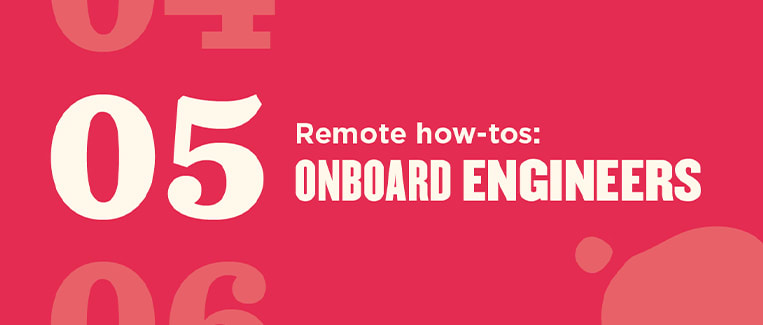How do you set up newly hired engineers for success? Start with a great onboarding process.
Research by Glassdoor found that organizations with a strong onboarding process improve new hire retention by 82 percent and productivity by over 70 percent. When you’re an engineering lead, a critical part of your role is helping other engineers grow and setting them up for success. That means making sure they have the tools and processes they need to have an impact from day one.
But how can you make new team members feel supported and included when they don’t have any face-to-face interactions? How can new employees experience the company’s culture when they work remotely?
While we understand that every onboarding process is unique to an organization, and there’s no one right answer, we want to focus on how remote engineering managers can set up a successful process for dispersed teams.
Manager onboarding checklist
First, managers should think about what new engineers and developers need to work remotely in their first eight to 12 weeks. This cohesive checklist can help you onboard new employees and set your entire team up for success.
Week 1: admin setup
- Draft a digital contract.
- Set up new employees across all internal systems (e.g., payroll).
- Create a data-driven review system for developer cultural fit, skills, project work and quality, and timeliness.
- Draft a welcome email, including links to the company’s intranet, the software required, knowledge and policies documents, first week plans, etc.
- Share the new remote team member’s details with your existing team.
- Have the developer conduct speed tests and test out hardware, and make sure a new employee is set up in their remote office with all equipment they need.
Knowledge sharing
- Find a mentor or buddy for the new hire.
- Draft company and team workflow documents.
- Create an initial project for all new hires with defined success metrics.
Meeting schedules
- Schedule one-on-one chats with other team members.
- Schedule a weekly one-on-one meeting for the first month with the remote developer.
- Send meeting requests for team-wide stand-ups.
- Communicate the company’s remote culture and set expectations.
- Brief new employees on day-to-day expectations.
- Brief new hires on review processes, and how their performance will be measured.
Next steps
Now that you have a checklist in place for yourself, here are some pointers to consider when you’re figuring out how to integrate your department and team onboarding processes with the company culture. For best results, managers should focus on taking a more data-driven approach to the onboarding process and development of an induction space that’s packed with all the information remote workers need. This can be the intranet, Slack, Microsoft Teams, or a platform where new hires can log in securely and adapt to the company’s culture.
Here are some additional best practices to consider as part of the onboarding process.
Be intentional about company culture
COVID-19 forced engineering teams into remote work, and remote (and hybrid) work are here to stay. To adapt to this new mode of work, engineering leaders are encouraged to migrate all icebreaker events to virtual formats.
For remote onboarding, start with being intentional about your company culture and introductions to each team member. This is incredibly important, as you can’t bring a new hire around to everyone’s desk and introduce them. For new hires to get the vibe of the company culture, managers need to foster a sense of belonging from the very start.“In my 20 plus years experience in the tech industry, it’s become clear that when you hire an engineer no matter where they come from it’s imperative to help them through your organization’s processes. This can be as simple as getting the right equipment and login information for their first day, to educating them on how to review code. It’s the simple things,” says Christine Wood, Director of Product Engineering, Cox Automotive.
Give everyone a buddy
According to HCI, 87 percent of organizations that assign a mentorship or buddy program during the onboarding process say that it’s an effective way to speed up new-hire proficiency. This “buddy” or “mentorship” system guarantees that each new hire has someone they can go to with questions they don’t feel like talking to their manager about.
How do you implement a buddy program? Just match a seasoned employee with your new hire. Request that they check in once a week for the first month, and one to two times per month thereafter, to make sure your new hire is acclimating to their new remote workplace.
Which organizations are doing this?
Zapier
On their website, Zapier explains what they “call … the ‘Zap Pal’ program. Every new hire is assigned a Zap Pal, who reaches out to them in their first week, sets up at least one Zoom call with them, and continues to check in throughout their first month or so. It gives everyone a guaranteed 1:1 relationship, which is so important when you’re spending most of your time alone in your house.”
Drop
“We don’t expect new engineers to have experience with our precise tech stack and so the first 3 weeks are allocated for ongoing education of architecture, frameworks, programming languages, and more,” says Ian Logan, VP of Engineering at Drop. “Beyond a new hire’s first 3 weeks, we help define a roadmap and mentor engineers to be increasingly autonomous, self-sufficient, and driven.”
Pair together for the first month
Many engineering leaders say the most thoughtful approach to onboarding new developers in a remote setting having them pair with seasoned team members. When employees code together, make sure the veteran employee actively makes time to drive the session for the new hire. “[Pairing] naturally fosters alignment across the team, and largely prevents early performance issues … this process also empowers happy and productive engineers,” says Steve Pereira, CTO at Statflo.
Recommended For Further Reading
Plan a weekly onboarding schedule
HCI states that most organizations stop their onboarding process just after the first week, leaving new hires feeling confused, discouraged, and lacking resources. Agreeably so, a week is hardly enough time for a new hire to become acclimated to their company, culture, and role.
To avoid this, engineering leaders should construct a week-by-week plan that fully supports new hires in a distributed environment.
Ted Goas from Stack Overflow says they comprehensively plan out every new hire’s first month in advance:
“We now have an onboarding process that spans a new hire’s first month, broken out by week. Everyone now knows what’s expected from a new hire after their first week, after their second, and so on. A new hire can skip ahead if they want, but expectations are clear and what should be happening at any given point.”
Establish a code review process as part of onboarding
Once new engineers are up and running, managers should establish weekly code review process tasks during the first month. This is an invaluable tool to ensure your team consistently learns from each other and recognizes any minor errors in the process. Code review also presents an opportunity for cross-pollinating information and expertise between team members. And new hires need to be part of this team culture to engage meaningfully with new teammates.

From Shiran Yaroslavsky
Shiran Yaroslavsky is the VP Product US at HiBob. She is the former CEO and Co-founder of Cassiopeia (acquired by HiBob), a startup that helps managers lead teams effectively with data. Shiran is a thought leader in people analytics and remote team leadership. She was featured in 2019 in Forbes’ 30Under30 list in Israel.

